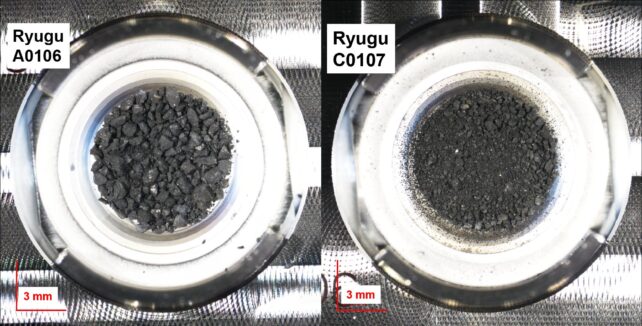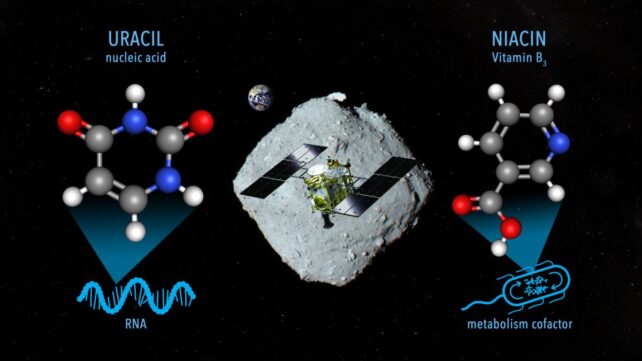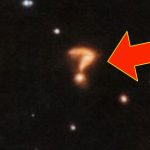Key Takeaways:
- RNA in Space: RNA nucleobases, including uracil, have been confirmed in asteroid dust collected from Ryugu, strengthening the theory that life’s building blocks exist in space.
- Clean Samples Confirm Findings: The samples obtained directly from Ryugu by the Hayabusa2 spacecraft were securely sealed, ruling out Earth’s contamination, thus validating the discovery of these organic compounds in space rocks.
- Potential Origins of Life: The presence of nucleobases, vitamins, amino acids, and other biomolecules in asteroids suggests that these celestial bodies might have contributed to the delivery of life’s ingredients to Earth through bombardment in its early history.
- Varied Organic Compounds: Alongside uracil, the samples also contained niacin, amino acids, amines, and carboxylic acids, hinting at a diverse array of organic molecules present in these space rocks.
- Future Exploration: Ongoing and upcoming missions, such as NASA’s OSIRIS-REx studying asteroid Bennu, aim to gather more data on asteroid compositions, potentially unveiling further insights into the origins of life.
A groundbreaking revelation has emerged from the examination of dust gathered from asteroid Ryugu, situated far from Earth. The scientific analysis of this extraterrestrial material unveiled the presence of RNA nucleobases, specifically uracil, one of the fundamental components constituting RNA. Additionally, niacin, a variant of vitamin B3 crucial for metabolic processes, was also detected in this asteroid dust, affirming the existence of essential organic molecules in space.
This significant discovery further solidifies the growing body of evidence supporting the hypothesis that the precursors of life originate in space and may have been transported to Earth through asteroid impacts during its early developmental phase.
Addressing concerns of contamination by Earth’s environment, astrochemist Yasuhiro Oba from Hokkaido University in Japan highlighted the integrity of the samples collected by the Hayabusa2 spacecraft directly from asteroid Ryugu, dismissing any potential contamination.
The quest to unravel the mysteries of life’s emergence and prevalence across the Milky Way has led scientists to explore the presence of life’s building blocks in space. Recent revelations indicate the abundant existence of these essential components within various cosmic phenomena, including planet-forming dust and star-forming clouds enveloping our galaxy’s core. Moreover, these crucial molecules have been identified in multiple meteorites that breached Earth’s atmosphere and landed on its surface.
However, certainties regarding the extraterrestrial origin of life’s precursors were elusive until the confirmation of uncontaminated samples brought back by Hayabusa2 from Ryugu.

Employing a novel detection method specifically designed for identifying nucleobases in minute quantities, Oba and his team meticulously examined the asteroid samples.
By subjecting the samples to high-performance liquid chromatography combined with electrospray ionization high-resolution mass spectrometry, they detected uracil in concentrations ranging from 6–32 parts per billion (ppb) and niacin in concentrations between 49–99 ppb. Furthermore, various other vital biological molecules like amino acids, amines, and carboxylic acids, essential for proteins and metabolism, were identified.

Although the biomolecules discovered in Ryugu samples differ from those in other carbon-rich meteorites, they exhibit striking similarities, suggesting the prevalence of biomolecules in carbonaceous meteorites.
Scientists speculate that compounds containing nitrogen could have formed from simpler molecules like formaldehyde, ammonia, and hydrogen cyanide. While these specific compounds weren’t found in Ryugu samples, their probable presence on the asteroid or its parent body, potentially a comet coated in nitrogen-rich ices in its early stages, is inferred.
The exploration doesn’t halt with Ryugu; NASA’s acquisition of a sample from another asteroid, Bennu, and its return to Earth for analysis presents another opportunity. Preliminary studies indicate organic materials consistent with life’s building blocks in Bennu.
This discovery of uracil in Ryugu samples fortifies existing theories regarding the origin of nucleobases on early Earth and emphasizes the importance of comparative studies between asteroids to enrich our understanding.
In essence, the essence of life, as we know it, might have traversed through space via asteroids. This research, published in Nature Communications, marks a significant leap in comprehending the cosmic origins of life’s fundamental building blocks.


